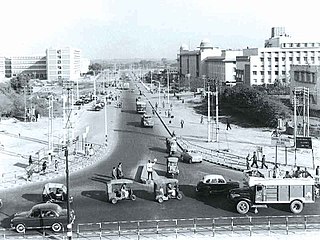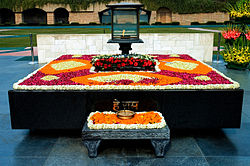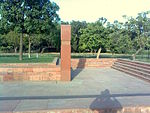
Shankar Dayal Sharma was an Indian lawyer and politician from the state of Madhya Pradesh who served as the ninth president of India, from 1992 to 1997.

Devi Lal, also known as Chaudhary Devi Lal, was an Indian statesman and politician who served as 6th Deputy Prime Minister of India from 1989 to 1990 and from 1990 to 1991. Lal emerged as farmer leader from the state of Haryana, and served as the Chief Minister of Haryana from 1977 to 1979 and then from 1987 to 1989. He was the founder of Indian National Lok Dal. He was popularly known as Tau, meaning uncle.

Gandhi Jayanti is an event celebrated in India to mark the birthday of Mahatma Gandhi. It is celebrated annually on 2 October, and is one of the three national holidays in India. The United Nations celebrates the day as International Day of Non-Violence. Called the "Father of The Nation" by Subhas Chandra Bose, Gandhi espoused one of the most well known philosophies of nonviolent resistance.
Kirit S. Parikh is Emeritus Professor and Founder Director of Indira Gandhi Institute of Development Research (IGIDR), Mumbai, India. He has also served as Senior Economic Advisor to United Nations Development Programme from October 1997 to September 1998. He has been a member of the Economic Advisory Council (EAC) for multiple Prime Ministers of India: Rajiv Gandhi, V.P.Singh, Chandra Shekhar, P.V. Narasimha Rao and Atal Bihari Vajpayee.
Gandhian socialism is the branch of socialism based on the national interpretation of the theories of Mahatma Gandhi. Gandhian socialism generally centers on Hind Swaraj or Indian Home Rule authored by Gandhi.

J. C. Kumarappa was an Indian economist and a close associate of Mahatma Gandhi. A pioneer of rural economic development theories, Kumarappa is credited for developing economic theories based on Gandhism – a school of economic thought he coined "Gandhian economics."
Phanindranath Rangarajan Kumaramangalam was a prominent politician of the Indian National Congress and later the Bharatiya Janata Party and a Member of parliament, Lok Sabha from the Salem constituency from 1984 to 1996 and Tiruchirapalli constituency from 1998 to 2000. He served as the Minister of State for Law, Justice and Company Affairs in the P. V. Narasimha Rao government from July 1991 to December 1993 and as the Union Minister for Power in the Vajpayee Government from 1998 to 2000. He was the grandson of former Chief Minister of Madras, P. Subbarayan and the nephew of former Indian Chief of Army, General P. P. Kumaramangalam.

Lakshmi Chand Jain (1925–2010) was a political activist and writer. Later, he served at various times as a member of the Planning Commission, as Indian High commissioner to South Africa, as a member of the World Commission on Dams (WCD) and as secretary of the Indian Cooperative Union and the All India Handicrafts Board (AIHB). His position as the ambassador was terminated as the Vajpayee Government felt that he had not defended India's position on Nuclear tests effectively in South Africa. He eventually joined the Indian National Congress. He was posthumously awarded Padma Vibhushan, the second highest civilian award, by the UPA government. However his family declined to accept the award, saying that Jain was against accepting State Honours.
Bishambhar Nath Pande was a freedom fighter, social worker, and parliamentarian in India. Pande devoted his life to the cause of national integration, and to the spread of the Gandhian way of life.

The National Gandhi Museum or Gandhi Memorial Museum is a museum located in New Delhi, India showcasing the life and principles of Mahatma Gandhi. The museum first opened in Mumbai, shortly after Gandhi was assassinated in 1948. The museum relocated several times before moving to Raj Ghat, New Delhi in 1961.

Yerawada is a neighbourhood of the city of Pune in the state of Maharashtra, India. Before that British Raj Yerawada was known as Yeraoda. Yerawada is one of the most densely populated areas in Pune. It is located at the beginning of Ahmednagar highway and also on the way to old Pune Airport at Lohagaon. This place can be reached after crossing Mula-Mutha River through Yerawada Bridge from Bund Garden.

Shakti Sthal is a memorial in Raj Ghat, New Delhi, India, marking the cremation site of Indira Gandhi. Politicians of the Indian National Congress traditionally visit the monument to pay tributes.

Pamulaparthi Venkata Narasimha Rao, popularly known as P. V. Narasimha Rao, was an Indian lawyer, statesman and politician who served as the 9th prime minister of India from 1991 to 1996. He was the first person from South India and second person from non-hindi speaking background to be the prime minister. He is especially known for introducing various liberal reforms to India's economy by recruiting Manmohan Singh as the finance minister to rescue the state from going towards bankruptcy during the economic crisis of 1991. Future prime ministers, Atal Bihari Vajpayee and Manmohan Singh, continued the economic reform policies pioneered by Rao's government. Rao was also referred to as Chanakya for his ability to steer economic and political legislation through the parliament at a time when he headed a minority government.

S. P. Varma is a social worker and peace activist from Jammu and Kashmir. He has been actively involved in peace-building efforts in conflict-ridden areas of the Kashmir valley.

The ITO barrage, also Indraprastha barrage and ITO Bridge, is a 552 meter barrage on Yamuna River, top of which also serves as the bridge on the Paharganj-Gaziabad Vikas marg. Yamuna flows for 48 km in Delhi, including 22 km from Wazirabad barrage where it enters Delhi to Okhla barrage after which it enters Haryana. Upstream barrage from ITO barrage in Delhi is Wazirabad barrage (north) and downstream is Okhla barrage (south). Yamuna has a total of 6 barrages, from north-west to south-east, Dakpathar Barrage (Uttarakhand), Hathni Kund Barrage, Wazirabad barrage, ITO barrage, Okhla barrage and Mathura barrage.

Sadashiv Sathe or Bhau Sathe was an Indian sculptor. His notable works include the 5-metre high statue of Mahatma Gandhi that is part of the main structure of the National Salt Satyagraha Memorial situated at Dandi, Navsari and the 18-foot equestrian statue of Shivaji at the Gateway of India, Mumbai.



























